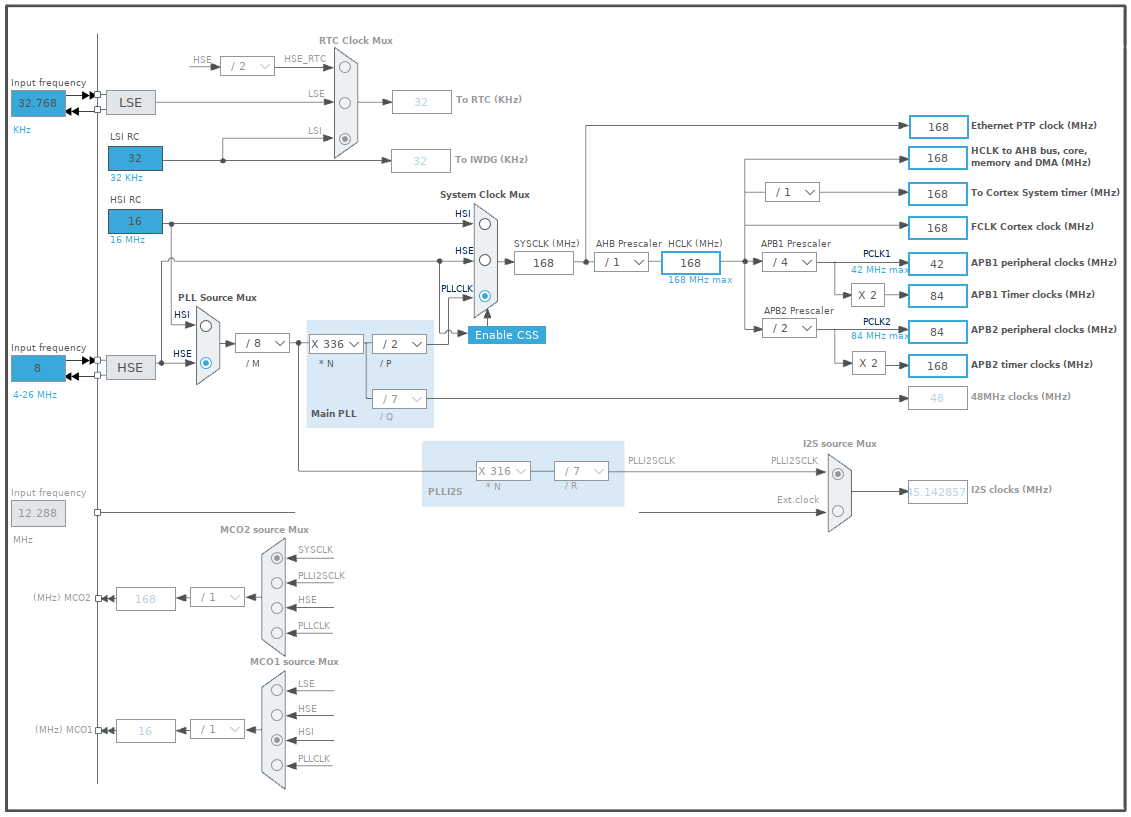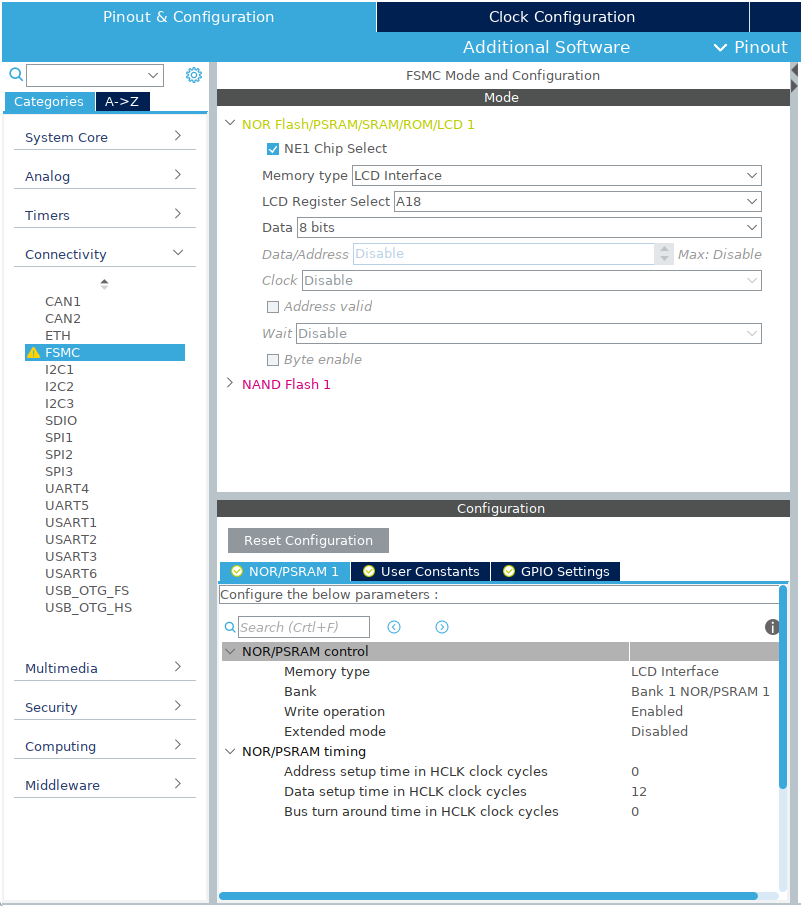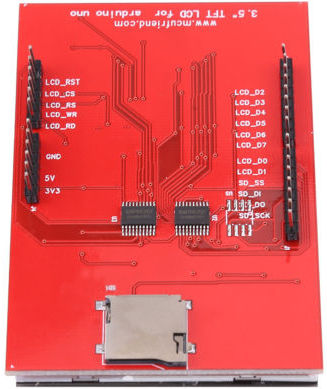3.5" inch TFT LCD Display Module 480X320 driven with FSMC.
TFT LCD Display Module 480X320 driven with FSMC
I have recently bought a 3.5" inch TFT LCD Touch Screen Display Module 480X320 with a www.mcufriend.com label on the back side. The display was equipped with an 8bit parallel interface. First I decided to test it with the UniGraphic library using the BUS_8 protocol. The display was very slow but improved when I switched to the PAR_8 protocol. Because I heard about the possibility to use a Flexible Static Memory Controller (FSMC), built into some STM MCU's, to drive LCD's (read/write to LCD's memory rather than to an external SRAM) I thought it would be a fun to try it out.

Below is the brief story of what I did:
- Created a project for my STM32F407VE board in the STM32CubeIDE
- Set the
Clock Configurationto match the one used by Mbed for the Seeed Arch Max board:
- Selected
FSMCin theConnectivitycategory and configured it as below:
- Let the
STM32CubeIDEgenerate the code (files). - Created a new program for the Seeed Arch Max target in the Mbed Online Compiler by selecting a
mbed os blinkytemplate. - Replaced the
main.cppwith themain.ccontent of theSTM32CubeIDEproject. Copy & Pastedthe other files with codes from theSTM32CubeIDEproject to the online compiler project.- Renamed and modified:
"stm32f4xx_it.h" to "stm32f4xx_it_msp.h"
"stm32f4xx_it.c" to "stm32f4xx_it_msp.c" - Added the UniGraphic library to the online compiler project.
- Extended the
UniGraphiclibrary with aFSMC_8protocol and replaced theTFT::set_orientation(int orient)function with the one used bymcufriendfor arduino. - Modified the
main.cppas needed.
 |  |
Wiring
| STM32F407VE | TFT LCD module |
|---|---|
| +3.3V | 3V3 |
| GND | GND |
| PB_12 | LCD_RST |
| GND | LCD_CS |
| PD_13 (RS) | LCD_RS |
| PD_5 (WR) | LCD_WR |
| PD_4 (RD) | LCD_RD |
| PD_14 (DB00) | LCD_D0 |
| PD_15 (DB01) | LCD_D1 |
| PD_0 (DB02) | LCD_D2 |
| PD_1 (DB03) | LCD_D3 |
| PE_7 (DB04) | LCD_D4 |
| PE_8 (DB05) | LCD_D5 |
| PE_9 (DB06) | LCD_D6 |
| PE_10 (DB07) | LCD_D7 |
Results
| Execution times | ||
|---|---|---|
| Used protocol | BUS_8 | FSMC_8 |
| Operation \ Time | ms | ms |
| Clear | 2283.980 | 38.454 |
| Plot | 192.066 | 11.365 |
| 8bit BMP | 63.805 | 41.338 |
| Large Font | 163.872 | 7.895 |
| Sparce pixels | 2072.265/1458.051 | 74.107/52.168 |
| 16bit BMP | 2288.589 | 59.904 |
UniGraphic/Inits/TFT_MIPI.cpp
- Committer:
- hudakz
- Date:
- 2020-09-25
- Revision:
- 1:47c996032a9e
- Parent:
- 0:fa952828e34c
File content as of revision 1:47c996032a9e:
/* mbed UniGraphic library - Device specific class
* Copyright (c) 2015 Giuliano Dianda
* Released under the MIT License: http://mbed.org/license/mit
*/
#include "Protocols.h"
#include "TFT_MIPI.h"
//////////////////////////////////////////////////////////////////////////////////
// display settings ///////////////////////////////////////////////////////
/////////////////////////////////////////////////////////////////////////
// put in constructor
//#define LCDSIZE_X 320 // display X pixels, TFTs are usually portrait view
//#define LCDSIZE_Y 480 // display Y pixels
TFT_MIPI::TFT_MIPI
(
proto_t displayproto,
PortName port,
PinName CS,
PinName reset,
PinName DC,
PinName WR,
PinName RD,
const char* name,
unsigned int LCDSIZE_X,
unsigned int LCDSIZE_Y
) :
TFT(displayproto, port, CS, reset, DC, WR, RD, LCDSIZE_X, LCDSIZE_Y, name)
{
hw_reset();
BusEnable(true);
identify(); // will collect tftID, set mipistd flag
init();
auto_gram_read_format(); // try to get read gram pixel format, could be 16bit or 18bit, RGB or BGR. Will set flags accordingly
// scrollbugfix=1; // when scrolling 1 line, the last line disappears, set to 1 to fix it, for ili9481 is set automatically in identify()
set_orientation(0);
// FastWindow(true); // most but not all controllers support this, even if datasheet tells they should. Give a try
cls();
locate(0, 0);
}
/**
* @brief
* @note
* @param
* @retval
*/
TFT_MIPI::TFT_MIPI
(
proto_t displayproto,
PinName* buspins,
PinName CS,
PinName reset,
PinName DC,
PinName WR,
PinName RD,
const char* name,
unsigned int LCDSIZE_X,
unsigned int LCDSIZE_Y
) :
TFT(displayproto, buspins, CS, reset, DC, WR, RD, LCDSIZE_X, LCDSIZE_Y, name)
{
// hw_reset();
// BusEnable(true);
identify(); // will collect tftID and set mipistd flag
init();
auto_gram_read_format();
set_orientation(0);
cls();
locate(0, 0);
}
/**
* @brief
* @note
* @param
* @retval
*/
TFT_MIPI::TFT_MIPI
(
proto_t displayproto,
int Hz,
PinName mosi,
PinName miso,
PinName sclk,
PinName CS,
PinName reset,
PinName DC,
const char* name,
unsigned int LCDSIZE_X,
unsigned int LCDSIZE_Y
) :
TFT(displayproto, Hz, mosi, miso, sclk, CS, reset, DC, LCDSIZE_X, LCDSIZE_Y, name)
{
hw_reset(); //TFT class forwards to Protocol class
BusEnable(true); //TFT class forwards to Protocol class
identify(); // will collect tftID and set mipistd flag
init(); // per display custom init cmd sequence, implemented here
auto_gram_read_format(); // try to get read gram pixel format, could be 16bit or 18bit, RGB or BGR. Will set flags accordingly
// scrollbugfix=1; // when scrolling 1 line, the last line disappears, set to 1 to fix it, for ili9481 is set automatically in identify()
set_orientation(0); //TFT class does for MIPI standard and some ILIxxx
// FastWindow(true); // most but not all controllers support this, even if datasheet tells they should. Give a try
cls();
locate(0, 0);
}
/**
* @brief
* @note
* @param
* @retval
*/
TFT_MIPI::TFT_MIPI
(
proto_t displayproto,
PinName reset,
const char* name,
unsigned int LCDSIZE_X,
unsigned int LCDSIZE_Y
) :
TFT(displayproto, reset, LCDSIZE_X, LCDSIZE_Y, name)
{
hw_reset();
identify(); // will collect tftID and set mipistd flag
init();
auto_gram_read_format();
set_orientation(0);
cls();
locate(0, 0);
}
// reset and init the lcd controller
void TFT_MIPI::init()
{
/* Start Initial Sequence ----------------------------------------------------*/
/* Start Initial Sequence ----------------------------------------------------*/
wr_cmd8(0xD0); // POWER SETTING
wr_data8(0x07);
wr_data8(0x42);
wr_data8(0x18);
wr_cmd8(0xD1); // VCOM control
wr_data8(0x00);
wr_data8(0x07);
wr_data8(0x10);
wr_cmd8(0xD2); // Power_Setting for Normal Mode
wr_data8(0x01); // LCD power supply current
wr_data8(0x02); // charge pumps
wr_cmd8(0xC0); // Panel Driving Setting
wr_data8(0x10); // 10 orig
wr_data8(0x3B); //number of lines+1 *8
wr_data8(0x00);
wr_data8(0x02);
wr_data8(0x11);
// C1 missing? Display_Timing_Setting for Normal Mode
//renesas does not have this
// wr_cmd8(0xC5); // Frame Rate and Inversion Control
// wr_data8(0x03); // 72hz, datashet tells default 02=85hz
wr_cmd8(0xC8); // Gamma settings
wr_data8(0x00);
wr_data8(0x32);
wr_data8(0x36);
wr_data8(0x45);
wr_data8(0x06);
wr_data8(0x16);
wr_data8(0x37);
wr_data8(0x75);
wr_data8(0x77);
wr_data8(0x54);
wr_data8(0x0C);
wr_data8(0x00);
wr_cmd8(0x36); // MEMORY_ACCESS_CONTROL (orientation stuff)
wr_data8(0x0A); // 0A as per chinese example (vertical flipped)
wr_cmd8(0x3A); // COLMOD_PIXEL_FORMAT_SET, not present in AN
wr_data8(0x55); // 16 bit pixel
wr_cmd8(0x13); // Nomal Displaymode
wr_cmd8(0x11); // sleep out
wait_ms(150);
wr_cmd8(0x29); // display on
wait_ms(150);
}